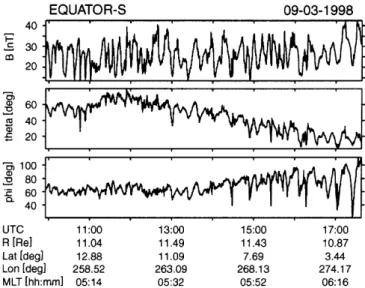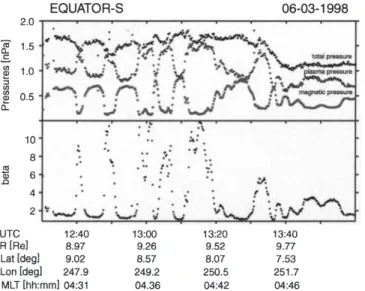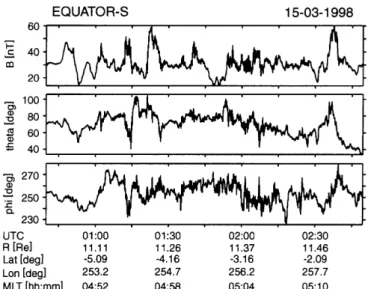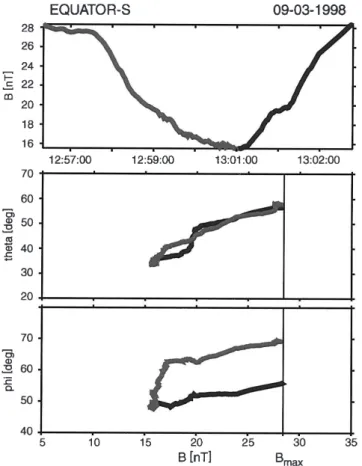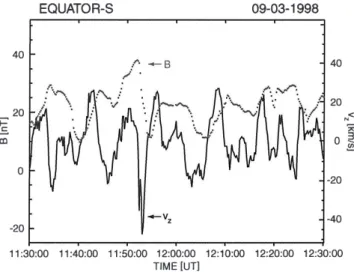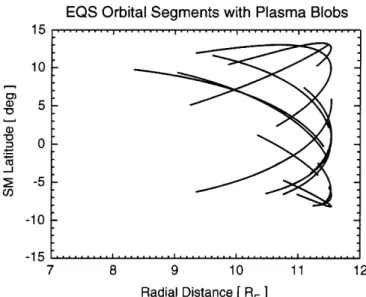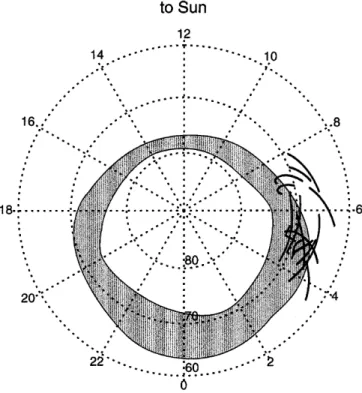High-beta plasma blobs in the morningside plasma sheet
G. Haerendel1, W. Baumjohann1, E. Georgescu1, R. Nakamura1, L. M. Kistler2, B. Klecker1, H. Kucharek1, A. Vaivads1, T. Mukai3, S. Kokubun4
1 Max-Planck-Institut fuÈr extraterrestrische Physik, Garching, Germany 2 University of New Hampshire, Durham, NH, USA
3 Institute of Space and Astronautical Science, Sagamihara, Japan
4 Solar-Terrestrial Environment Lab., Nagoya University, Toyokawa, Japan
Received: 28 June 1999 / Revised: 23 July 1999 / Accepted: 17 August 1999
Abstract. Equator-S frequently encountered, i.e. on 30% of the orbits between 1 March and 17 April 1998, strong variations of the magnetic ®eld strength of typically 5±15-min duration outside about 9RE during the late-night/early-morning hours. Very high-plasma beta values were found, varying between 1 and 10 or more. Close conjunctions between Equator-S and Geo-tail revealed the spatial structure of these ``plasma blobs'' and their lifetime. They are typically 5±10 wide
in longitude and have an antisymmetric plasma or magnetic pressure distribution with respect to the equator, while being altogether low-latitude phenomena 15. They drift slowly sunward, exchange plasma
across the equator and have a lifetime of at least 15±30 min. While their spatial structure may be due to some sort of mirror instability, little is known about the origin of the high-beta plasma. It is speculated that the morningside boundary layer somewhat further tailward may be the source of this plasma. This would be consistent with the preference of the plasma blobs to occur during quiet conditions, although they are also found during substorm periods. The relation to auroral phenomena in the morningside oval is uncertain. The energy deposition may be mostly too weak to generate a visible signature. However, patchy aurora remains a candidate for more disturbed periods.
Key words. Magnetospheric physics (plasma convection; plasma sheet; plasma waves and instabilities)
1 Introduction
Equator-S had a very short lifetime, and not all of the instruments functioned as planned. The available data set is thus incomplete and restricted to the period 16
December 1997±30 April 1998, and a local time interval from 11 MLT to 02 MLT. In spite of these rather severe limitations, the mission produced some novel data. This is mainly due to the low inclination (3.9) and eccentric
orbit (apogee 11:5RE geocentric, perigee 500 km alti-tude). Not only did this orbit allow the study of the prenoon magnetopause and low-latitude boundary layer, but the spacecraft was also subsequently, i.e. after about 1 March, carried into one of the least explored regions of the outer magnetosphere, the low-latitude plasma sheet between 9 and 11:5REand 07 and 02 MLT. Because of their higher inclination, most earlier magne-tospheric satellites on eccentric orbits missed this region or, when it was encountered, the investigators concen-trated on the more spectacular magnetopause crossings. Therefore, little was added to the pioneering work of Heppner et al. (1967) based on the OGO-A ¯uxgate magnetometer measurements.
OGO-A could explore the local time sector from 04:30 to 06:30 at geomagnetic latitudes between 15
out to and beyond the magnetopause on a number of inbound passes. The main ®ndings were: (a) a vanishing gradient of the total magnetic ®eld between 11RE and the magnetopause, (b) in a number of cases little contrast between the behavior of magnetospheric and magnetosheath ®elds, and (c) at times higher ®elds outside rather than inside the magnetopause. Based on these ®ndings, Heppneret al.(1967) concluded that the low-latitude region between 11RE and magnetopause was characterized by a high value of the plasma beta b2lop=B21. Furthermore, on a number of out-bound passes at latitudes >24 and inside the
magne-topause, they found intervals of up to 2-min duration during which the magnetic ®eld changed greatly, and suggested the existence of ``some degree of blobbiness'' of the plasma and ®eld structure, without being able to characterize these features more accurately. Equator-S data can now throw more light on this region.
It will be subsequently shown that in one third of all orbits, between about 9.3 and 11:5RE and SM latitudes below about 13, extended periods are found during
which magnetic-®eld magnitude and direction change dramatically for intervals of several up to 15 min. In a subset of these events, we were able to determine the plasma pressure and found high-beta values, sometimes exceeding 10 in the ®eld depressions. Following the language of Heppner et al. (1967) we name these depressions ``plasma blobs''. Their longitudinal dimen-sions are of order 1RE.
Complementary information on these blobs may be derived from the conjugate morningside aurora. As will be shown, the locations of their occurrence were conjugate with the equatorward region of the morning-side auroral oval between 03:30 and 08:00 MLT. The most characteristic auroral phenomenon of this region is the patchy aurora, typically appearing about 10±30 min after substorm onset in the midnight section with typical sizes of 100±200 km Akasofu et al. (1966), but also existent during quieter conditions Oguti (1981). The shapes of the patches are quite irregular, and they drift slowly eastward with speeds of a few 100 m/s. Oguti (1981) interprets the movements as manifestations of real plasma drifts in the magnetosphere.
Our presentation of plasma blobs will ®rst deal with individual observations and characterize their plasma and ®eld structure. Then we will analyze their spatial scales and motions, which was made possible through a few conjunctions of Equator-S with Geotail. Next we will discuss the occurrence of these events in space and according to magnetic activity. Field-line tracing yields the conjugate sites in the ionosphere and leads to a discussion of the relation with the morningside aurora. Finally, we will speculate on the origin of the plasma blobs.
2 Instrumentation
The Equator-S magnetic ®eld instrument is fully de-scribed in Fornaconet al.(1999). It consists of two units with a pair of three-axes ¯uxgate magnetometers each. The sensors of the primary and the redundant units are mounted on two rigid booms, with the main sensor located at the end of the 1.8-m boom and the other 50 cm further inboard. The sampling rate is 128 vectors/s in normal mode, when only the outboard magnetometer is used, and 64 vectors/s for dual mode operation. The amplitude resolution is 16 bits, and the ranges are selected automatically in steps of 4 between 256 and 64000 nT. The data used in the present study are mainly 128 Hz data, all sampled with a resolution of about 10 pT in the 256 nT mode.
The Ion Composition Instrument (ICI) measures the 3-dimensional distribution functions of the major ion species in the magnetosphere and magnetosheath over the energy per charge range 20±40000 eV/e Kistleret al.
(1998). It is a combination of a top-hat electrostatic analyzer followed by post-acceleration of 15±18 kV, and then a time-of-¯ight measurement, similar to the CIS1 instrument designed for CLUSTER (ReÁme et al., 1997) and the TEAMS instrument on FAST (MoÈbius et al., 1998). It can resolve the major ion species, H, He,
He, O, and O. In the high-rate mode of the data acquisition, full velocity distributions are obtained every spin period (1.5 s), in low rate every 6 s. The onboard moments are calculated every spin period.
3 Nature of the plasma blobs
A common observation of Equator-S in the morningside plasma sheet outside about 9RE and at SM latitudes below 13 is that of large semiperiodic ¯uctuations of
magnetic ®eld strength and orientation with durations of several minutes. On about one third of all orbits between 1 March and 17 April, i.e. between 07 MLT and 02 MLT such large-amplitude ¯uctuations were ob-served. Figure 1 shows a striking example.
The plasma data obtained with the ICI Kistleret al.
(1998) show corresponding variations of the plasma pressure, in antiphase with the magnetic pressure, albeit with much smaller relative amplitude. The long time-scales of the variations in the presence of magneto-acoustic speeds of the order of 1000 km/s suggest magnetostatic rather than dynamic equilibrium between the high and low (magnetic) pressure regions. The observed ¯ow velocities of a few tens of km/s con®rm this suggestion. The widely dierent relative amplitudes of the magnetic and plasma pressure variations can only be reconciled if the plasma beta is larger than unity. A direct derivation of the plasma pressure from the ICI using eciencies determined from ground calibrations gives densities which are too low to produce the expected pressure equilibrium. The reasons for these discrepancies are still being resolved. To overcome this impediment, the following procedure has been em-ployed.
We assume approximately constant total pressure over an extended time interval, typically 1 h, and try to match the measured magnetic ®eld and plasma pressure values with
p B
2
2lopo
B2o
2loconst. ; 1
for a number of individual pressure variations. This means that we disregard the contribution of magnetic shear stresses, which will be justi®ed in retrospect, when we have analyzed the spatial structure of the blobs.
The calibration procedure can be brie¯y character-ized as an attempt to ®t the magnetic pB, thermal pth and total pressures ptotto the equations:
pBapthptot : 2
If our assumption of magnetostatic equilibrium with negligible shear stresses is valid and ifpthwere measured reliably, one should ®nd a ÿ1. This is invariably not the case, ÿaexceeds unity typically by factors of 2±5. But extrapolation of a linear ®t of the scattered data to
pth0 yieldsptot. We then correct the measured data of
pth by multiplying them withÿa.
One can regard the temperature determination from the energy distribution of the protons as much more reliable than the density derivations. Therefore, the correction ÿa should apply to the density values. In the few cases of close conjunction with the Geotail spacecraft this conclusion is supported by a comparison with its density measurements.
Figure 2 shows plasma and magnetic ®eld measure-ments and derived quantities from an outbound orbit of Equator-S on 18 March, 1998. At about 9RE (14:37 UTC) a change in the character of the magnetic ®eld is observed. It exhibits short-term (i.e. few minutes) variations, a slight drop in magnitude and increasing directional variations. This behavior is obviously con-nected with an increase in plasma pressure followed by a rather sudden jump shortly before 15:00 UTC. While the spacecraft moves outward and B decreases, the plasma beta grows well above unity. Outside about 10 RE, beta
undergoes strong variations, which become quite regular between 18 and 19 UTC. It is this period that we used to ®x the correction factor ÿa (=4.1) by postulating constant total pressure. Applying this factor throughout the whole data period, we ®nd a remarkable constancy of the pressure outside about 9RE.
Figures 3 and 4 present further examples of strong variations of the magnetic and plasma pressures. Den-sities and temperatures are in the same range as in Fig. 2. However, not always can one ®t the data of a long period with constant total pressure. Temporal changes as seen in Fig. 3 after 13:33 UTC are not uncommon. But nearly constant total pressure for 1 or 2 h is normally a non-con¯icting assumption.
All examples shown demonstrate that the strong variations of magnetic pressure are embedded in a very high-beta environment. Even in the maxima of B, beta hardly ever falls below unity, whereas in the minima beta reaches or even exceeds 10. This ®nding led to the choice of the name plasma blobs. Obviously, a high-beta plasma (on averageb3) is injected into the
morning-Fig. 2. Plasma and magnetic-®eld measurements plus derived quan-tities on an outbound orbit of Equator-S on 18 March 1998. Outside about 10RE, large-amplitude variations of magnetic ®eld strength and
orientation are found in a high-beta environment
Fig. 3. Recalibration of measured plasma pressure so as to yield approximately constant total pressure for 1 h (see text) and corresponding plasma beta 2lop=B2 on 9 March 1998. After
side plasma sheet at low latitudes and arranges itself spatially in a way that regions of very high b 10 alternate with a region of b1. The easiest way to establish such a con®guration is by redistribution of the hot plasma along magnetic ®eld lines. We will return to this point after having analyzed the spatial structure.
Similar high-beta plasma variations had already been observed by Geotail in the early morning sector, a few
RE further outward than reported here and have been interpreted as slow mode or mirror mode waves Nishida
et al.(1997).
4 Spatial structure
The magnetic structure of the plasma blobs can be divided in two classes, regular and irregular. The data of 18 March shown in Fig. 2 are an example of the ®rst class. Figure 5 presents an example of the irregular class. The latter has not yet been subjected to the pressure balance analysis described in the previous section, however, rough inspection con®rms also here the high-beta nature. The regular variations are the rarer class. They were observed on about 40% of the periods with
strong magnetic variations, mostly for only part of these periods.
Typically the drop in magnetic ®eld strength is accompanied by a characteristic change in ®eld direction in the following sense. With decreasingBalso the polar angle, H, decreases, i.e. the magnetic vector steepens with respect to the (SM) equatorial plane. The azimuthal angle,/, changes little, whileB is decreasing, but then, in the bottom of the magnetic depression, it changes signi®cantly. Figure 6 shows one out of many examples from the 9 March period (cf Fig. 1). Figure 7 summa-rizes in a sketch the most commonly observed variations ofB,H,/, within the regular class. The polar angle,H, drops typically by about 20 inside the ®eld depression (plasma blob). The change of azimuth (depending on the value ofH) is mostly, but not always negative, i.e. the ®eld vector is tilted by typically 20 sunward.
The change in polar angle, asB is dropping and the plasma pressure is increasing, must be related to an inhomogeneous accumulation of the plasma. There are two possibilities. In principle, dense plasma could be supplied from lower altitudes and, while in¯ating the ®eld, steepen the magnetic vector. The other possibility is that plasma ¯ows in from high altitudes, i.e. lower latitudes or from the opposite hemisphere and assembles non-symmetrically with respect to the equator. The question can be answered by analyzing the parallel component of the plasma ¯ow. For demonstration, we choose data from Geotail for one of the conjunctions with Equator-S. On 9 March the closest approach of GTL and EQS occurred at 12:15 UTC. EQS was at
R11:4RE and 12:1 northern SM latitude, whereas GTL was south of the equatorial plane, at a latitude of ÿ5:8 and slightly further inward, i.e. at R = 10.97RE.
Figure 8 shows, for a 1 h period around the time of conjunction the mostly ®eld-aligned z-component of the plasma ¯ow and the magnitude of B as measured by Geotail. (The actually measured vz has been shifted by 20 km/s, so as to yield an almost vanishing mean velocity. Such a shift of the zero-line is well within the
Fig. 4. Same as Fig. 2, but without total pressure, for 3 April and 9 April 1998
errors of the velocity determination.) With a phase shift of about 90 vz maximizes before the maximum of B. This also holds for the times before and after the interval shown. Because of the anticorrelation of pand B, this means that the ¯ow is towards the equator vz>0 when p decreases and away from the equator as p is building up. The velocity amplitude ranges between about 20 and 40 km/s. The transverse velocity compo-nents are too small to be reliably interpreted.
These ®ndings imply that the mass reservoir must be at lower latitudes or beyond, in the opposite hemisphere. This is consistent with Heppneret al.(1967) who found the high-beta region to lie below about 15 latitude. At the position of the spacecraft, plasma is arriving from the equator, the ®eld is in¯ated and the elevation angle steepens at the low-latitude side of the blobs.
Figure 9 provides a plausible interpretation of plasma movements, ®eld in¯ation and elevation increase. But it goes a step further by implying a N-S antisymmetry. The existence of such an antisymmetry is revealed by simultaneous measurements north and south of the magnetic equator along essentially the same ¯ux-tube, which were possible during the conjunctions of EQS and GTL on 9 March and 25 April. Figure 10 shows B for both, EQS and GTL, of 9 March for 4 h around the time of conjunction. Within 15 min of 12:15 UTC (closest approach of EQS and GTL in longitude), the
strong variations of B at both spacecraft are clearly in antiphase. TakingBas a proxi forpwe ®nd a pressure maximum at EQS when the magnetic pressure has a maximum at GTL and vice versa. Figure 11 is an attempt to visualize this antisymmetric ®eld-plasma distribution.
The antisymmetry of B and p with respect to the equator and the observed ¯ow directions suggest that the blobs owe their existence to a rearrangement of the high-beta plasma alternatingly northward and south-ward of the central plasma sheet. Build-up of magnetic pressures on one side seems to accelerate the plasma towards the other side of the equator, where it piles up under in¯ation of the magnetic ®eld.
What is then the reason for the observed quasi-periods ofBand p? Do they show growth and decay of the blobs or rather a convected spatial structure? The conjunctions of EQS and GTL provide the answer. Looking again at Fig. 10, one notices that the variations ofBon both spacecraft change from being in antiphase at the time of (longitudinal) conjunction to being in phase at about 1 h before and after. At these times, EQS and GTL were separated by about 4:5in SM longitude.
At the equator this corresponds to a separation of 0.85
REor5500 km. Because of the N-S antisymmetry this distance must indicate the half width of an individual blob. The same evaluation for the 25 April conjunction
Fig. 6. An example of the detailed variation of magnitude (B), polar angle (theta), and azimuth (phi) of the magnetic ®eld in one of the ®eld depressions (plasma blobs) observed on 9 March 1998. Theta and phi are plotted versusB, decreasing phase indicated bythick line
yields about 8000 km. If we take as typical width 10 000 km and take into account that EQS or GTL see about seven blobs per 1 h on 9 March, one derives
an average transport velocity of20 km/s with respect to the spacecraft (vGTL2:8 km/s). This is quite consis-tent with the averagevx-component (essentially perpen-dicular toB) measured with GTL within the uncertainty of about 20% with which such low velocities can be measured. The positive value of vx means sunward transport, quite in agreement with the general direction of plasma convection in the morning sector.
The consistency of the above determination of the transport velocity from width and passage time with the local ¯ow measurements testi®es that the blobs have a lifetime substantially longer than the passage time past the satellite. Therefore, if we want to assess the implications of the observed ®eld-aligned ¯ow compo-nents of 20±40 km/s, we must consider transport times well beyond the passage time of 2±4 min for the rising or
Fig. 8. Phase relation between magnetic ®eld magnitude (dotted line) and ®eld-parallel ¯ow component (full line) as observed by Geotail during the conjunction with Equator-S on 9 March 1999. vz is
directed equatorward whenBis rising, i.e. when the plasma pressure south of the equator is decreasing and vice versa
Fig. 9. A view of the ®eld distortions in the meridional plane due to the concentration of plasma and accompanying ®eld in¯ation at o-equatorial latitudes
Fig. 10. Phase relation between the magnetic ®eld magnitudes at EQS (thin line) and GTL (thick line) and s/c positions in SM coordinates near the conjunction on 9 March 1998
falling part of a typical blob. We should expect that build-up of a blob requires the displacement of the plasma by a distance exceeding that of Equator-S from the equator, since an asymmetric plasma pressure distribution with respect to the equator has to be established. As the typical steepening of the ®eld elevation angle is found up to SM latitudes of 10 and beyond, an average ®eld-parallel plasma displacement of 3RE should represent a lower limit. Dividing this length by the above parallel velocity range yields build-up times between 500 and 1000 s, which would correspond to lifetimes at least twice as long, i.e. 17±35 min, and substantially longer than the passage time. An upper limit of the lifetimes cannot be easily established. It would need tracing of individual blobs.
In summary, we have identi®ed the high-beta plasma blobs in the morningside plasma sheet as being created by rearranging dense plasma in a semi-periodic and anti-symmetric way (with respect to the equator). Lifetimes are long, substantially longer than the magnetic varia-tions of order 5±10 min seen by the satellites. To call these variations Pc5 is thus not appropriate. They are certainly no ®eld-line resonances or compressional oscillations. The identi®cation as mirror mode waves inside the magnetosphere Nishida et al.(1997) appears to be more appropriate. The slow sunward drift suggests that the ultimate origin of the high-beta plasma is the tail plasma sheet in the late night sector.
With the thus achieved insights into the spatial structure of the plasma blobs, we can now justify the neglect of the magnetic shear stresses in Eqs. (1) and (2). Inspection of Figs. 1±6 and 10 shows that the magnetic ®eld strength mostly drops rapidly, typically within 1 min, and varies more slowly around Bmin. With a
convection speed of about 20 km/s this amounts to a gradient length of the plasma pressure of the order of 1000 km. Even where the ®eld is locally in¯ated, its curvature radius is still of the order of several RE. The pressure balance is therefore essentially maintained by the magnetic normal pressure.
5 Occurrence
Large-amplitude magnetic ®eld variations are a com-mon phenomenon in the morningside plasma sheet. EQS encountered such variations on 30% of the orbits between 1 March and 17 April 1998. Figure 12 shows their occurrence in a SM latitude versus geocentric distance diagram. They are clearly a feature of the outer magnetosphere, outside 9RE and restricted to low latitudes 15. The latter statement is based on the observations of OGO-A Heppner et al. (1967), since the EQS orbit is con®ned to low latitudes. Also based on the OGO-A and Geotail Nishida et al. (1997) ®ndings we conclude that these ¯uctuations exist outside the EQS apogee of 11:5RE, out to the magnetopause/ boundary layer. At the present state of data reduction, we can, however, not be certain that all of the large-amplitude magnetic ¯uctuations, regular and irregular, occur in a very high-beta plasma, but it is a natural
expectation. This is why we will also use the designation plasma blobs for the periods of large-amplitude mag-netic variations, without having the actual evidence from the plasma measurements in each individual case. A very revealing aspect is the geomagnetic activity at the times of blob encounter. Of 48 data periods of varying length, 13 took place during Kp = 1 condi-tions, 22 during Kp = 2, 12 during Kp = 3, and 1 during Kp = 4. The blob occurrence clearly appears to favor geomagnetic quiet conditions, as the distribution over Kp = 1 to 4 was 6:7:3:1. Of the class of regular variations, 7 in total, 5 occurred during Kp = 1 and 2 during Kp = 2.
It is rather surprising that the intrusion of very high-beta plasma and its quasi-periodic spatial organization in the outer morningside magnetosphere should be most ecient during quiet magnetic conditions. That this plasma was a residue of an earlier injection during disturbed, e.g. substorm, conditions, is rather unlikely in view of the observed sunward ¯ow with a speed of typically 20 km/s. A convection through the midnight-to-dawn sector at 11RE would take only 1.5 h. By contrast some of the most pronounced blob periods, e.g. 1 April 1998, were encountered after 4±8 h of extremely quiet magnetic conditions. Therefore, one is led to conclude that it is the preservation of the high-beta nature and of the blobby structure that determines the occurrence rate. During disturbed periods, the magne-tization ofb1 plasma may just proceed more rapidly.
6 Relation to the aurora
The role of the plasma blobs as a potential source region of the aurora is an interesting question. The high-beta plasma inside the magnetosphere does not only in¯ate the magnetic ®eld, but it appears to be convected sunward against the friction exerted by the ionosphere on the corresponding ¯ux-tubes. So, ®eld-aligned currents are
generated, and auroral phenomena may be associated. Figure 13 exhibits the traces of the orbital segments with blob occurrence (see Fig. 12) in the conjugate northern ionosphere, superposed on the location of the statistical auroral oval of Feldstein (1963). The tracing was performed by using the 1989 Tsyganenko model (Tsyga-nenko, 1989) for the actual values of Kp. Since the ®eld in¯ation due to presence of the high-beta plasma at low latitudes is not incorporated in the Tsyganenko model, a correction of the conjugate latitude by about 1or so, may be appropriate, but was not applied. Figure 13 thus seems to suggest a concentration of the blobs to the equatorward side of the auroral oval, but one has to remember the 11:5REapogee of EQS which did not allow to explore ®eld lines with conjugate magnetic latitudes beyond71. If, as suspected above and con®rmed by the Geotail measurements of Nishida et al. (1997), the high-beta plasma with blobby structure exists out to the magneto-pause, they should have conjugate traces all over the morningside oval.
Projection of longitudinal extent and the transport velocity of the plasma blobs to the conjugate ionosphere yields E±W scales of200 km and drift speeds along the oval of 400 m/s. These numbers as well as the occurrence in the morning sector are reminiscent of the patchy aurora found in the auroral oval near dawn Akasofuet al.(1966). However, there are crucial dier-ences. The patchy aurora typically appears some 15±30 min after the onset of a substorm in the midnight sector, it develops out of a homogeneous arc at the
equatorward edge of the oval and is hardly ever observed poleward of dip latitudes of 70. The plasma blobs, on the other hand, do not seem to be restricted to the inner edge of the plasma sheet, more importantly, they favor quiet conditions. They can even exist during long periods of Kp = 1, whereas in the morningside oval ``quiet and homogeneous arcs are common auroral forms'' Akasofuet al.(1966).
On the other hand, the occurrence of aurora in the dawn sector is not restricted to substorm recovery. Oguti (1981) describes the existence of patchy aurora poleward of 70at dawn during 0Kp1. Davis (1963) found a high occurrence rate (67%) at Byrd, Antarctica (ÿ70.6 geomagn. lat.) until about 05 local time, which drops drastically during subsequent hours. The aurora exhibits rayed arcs on the southern (i.e. poleward) side, diuse homogeneous arcs further north, and equatorward thereof diuse surfaces. Eastward motions prevail. Often these motions are seen to cease while the aurora is still observable for several tens of minutes. Sometimes a westward reversal occurs during late-night hours.
While a detailed auroral counterpart of the plasma blobs can not be identi®ed at this stage of our investigation, we can conclude that there are observable auroral signatures in the conjugate ionosphere, but they seem to fade rapidly at local times beyond about 05 U.T. This implies that the energy content of the blobs is decreasing during these hours until they do no longer give rise to auroral particle acceleration. A quick estimate con®rms this suspicion.
A projected drift speed of 400 m/s corresponds to an essentially southward pointing electric ®eld of 20 mV/m in the auroral ionosphere. Even at quiet times at sunrise, there is a high Pedersen conductivity (up to 8 mho) created by diuse aurora, but it falls o rapidly with increasing latitude Newellet al.(1996).Rp6 mho may be a good assumption, not more than probably an upper limit. So, underneath the blobs an integrated Pedersen current,Jp, of 0.12 A/m may ¯ow. If the N±S scale,`N, of the blobs is not dissimilar to the E±W scale, this current should connect to a ®eld-aligned current of
Jp= 0:5`n, which is at best 1.2lA=m2, if `N is only 200 km. Such ®eld-aligned current strengths are only marginally sucient to set up an auroral acceleration region. Without post-acceleration, the associated ¯ux of plasma sheet electrons, whose temperature should be of orderTp=7, i.e.400±500 eV, would be close to 0.6 ergs/ cm2 s, too low for a visual signature. However, plasma
blobs of higher energy content may be the magneto-spheric origin of patchy aurora during the recovery phase of a substorm, or of the rayed aurora typical for dawn during quieter hours [Hallinan, 1999; private communication].
7 Summary and discussion
We have presented data from the Equator-S mission, supplemented by measurements of the Geotail satellite, showing the existence of very high-beta plasma blobs as a common phenomenon in the morningside plasma
sheet. The plasma beta ranges from about 1 to 10 and more. The plasma and magnetic pressure distributions are antisymmetric with respect to the magnetic equato-rial plane, their E±W extent is 1±2REand their lifetime at least 1000±2000 s. They drift slowly east- and sunward at speeds of typically 20 km/s. They have a preference for magnetically quiet periods, in particular the more regular variations, but can also exist during substorm conditions. Their overall occurrence rate is near 30%. One additional and perhaps surprising feature is that in spite of the large variations in magnetic ®eld strength (and beta) the orientation of the ®eld is still reminiscent of a dipole geometry and, far from being chaotic, exhibits very systematic deviations from the model ®elds which, of course, do not incorporate the existence of such blobs.
There are essentially two questions raised by the discovery of these blobs. What is their nature and what their origin? Taking the high beta for a moment for granted, we should ®rst concentrate on their lifetime and the N±S antisymmetry. The lifetime of 15±30 min minimum precludes the interpretation as Pc5-type ®eld-line resonances Jacobs (1970) coupled to or excited by compressional waves, since the travel times of AlfveÂn waves between the two conjugate hemispheres, which constitute an upper limit to the periods, are at best 5 min. For instance, the AlfveÂn speed in the high pressure, low ®eld part of a blob Bmin 12 nT, nmax'2 cmÿ3is about 200 km/s. A ®eld-aligned extent
of the pressure maximum of 6RE is certainly an upper limit. An AlfveÂn wave would need about 3 min to traverse this part of the ®eld line, while the higher latitudes need no more than additional 2 min. The considerably longer lifetime found testi®es that we are dealing here with long-lived plasma intrusions reminis-cent of the mirror mode waves found, also by Equator-S, in the magnetosheath adjacent to the magnetopause (e.g. Tsurutaniet al., 1982; Luceket al., 1999).
In earlier studies of Pc5 waves encountered at or near geostationary orbit, e.g. Brownet al.(1968); Lanzerotti
et al. (1969); Takahashi et al. (1985), and further out-ward Hedgecock (1976); Yumoto et al.(1983); Greens-tadt et al. (1986); Takahashi et al. (1987), the authors attributed the oscillations either to ®eld line resonances (AlfveÂn waves) or compressional magnetosonic waves excited either by the Kelvin-Helmholtz instability or by the drift mirror instability. Having excluded ®eld line resonances on the grounds of the long lifetimes derived in this study, there remains the possibility of non-oscillatory mirror waves Priceet al.(1986) excited by an internal plasma instability, like the drift mirror bility of Hasegawa (1969) or ballooning-mirror insta-bility Cheng and Qian (1994). Because of lack of full information on all dominant plasma constituents and their anisotropies, we can not check whether the conditions for this instability are ful®lled. However, the structuring in longitude and the antisymmetric distribution in latitude may well be the result of the high-beta plasma ®nding a lower energy state. Indeed, the antisymmetry implies that several degrees o the magnetic equator the ¯ux-tubes are ordered in a way
that ``belly'' and ``neck'' are alternating, similar to the ®ndings from simulations by Price et al. (1986; their Fig. 8a). This is intuitively the most ``economic'' pack-ing of in¯atable ¯ux-tubes in a dipole geometry. Also Southwood (1976) found for such a geometry instability only for antisymmetric perturbations, albeit for the AlfveÂn mode andb1, so not directly applicable here. Cheng and Qian (1994) showed that when energetic-trapped particle-kinetic eects are taken into account, symmetric ballooning-mirror modes are stabilized and antisymmetric modes become most unstable. The mode structure is similar to those observed by Takahashiet al.
(1987) and reported here.
While the spatial structuring may well be a conse-quence of some sort of mirror instability, this does not explain the origin of the very high beta plasma. Very high beta values, up to 70, have been found in the midnight sector at the end of the growth phase of a substorm and one may wonder what happens to this plasma after substorm onset. Haerendel (1999a) pro-posed on the basis of a ®rst inspection of the here reported measurements that the morningside blobs may be residues of this pre-substorm high-beta plasma near Earth. This may, indeed, be the case for periods following substorm onsets in the midnight sector, but it is hard to believe that this is an explanation for the blobs found during quiet periods with no substorm preceding for many hours.
The high-beta plasma blobs in the morningside mag-netosphere are a new plasma regime in near-Earth space. At this time, we can only speculate about their origin, the reasons for their spatial structure, the conditions for their appearance and, last not least, their overall con®nement, which typically requires the equivalent pressure of a 50-nT magnetic ®eld, i.e. 1.0 nPa. Such pressures are not commonly found in the magnetosheath on the morning ¯ank. Further and deeper studies are needed in order to shed light on all these topics.
Acknowledgements. The Equator-S program was supported by DARA, later DLR under grant 50 0C 94024. Our thanks belong to all teams which contributed to spacecraft development, launch, and operations and also to ESA and NASA for their contributions and support.
Topical Editor G. Chanteur thanks J-A. Sauvaud for his help in evaluating this paper.
References
Akasofu, S.-I., C.-I. Meng, and D. Kimball, Dynamics of the aurora. VI. Formation of patches and their eastward motion,
J. Atmos. Terr. Phys.,28,505±511, 1996.
Brown, W. I., J. Cahill, L. R. Davis, Acceleration of trapped Particles during a magnetic storm on April 18, 1965,J. Geophys. Res.,73,153±164, 1968.
Cheng, C. Z., and Q. Qian,Theory of ballooning-mirror instabil-ities for anisotropic pressure plasmas in the magnetosphere,
J. Geophys. Res.,99,11193±11209, 1994.
Davis, T. N., and R. N. DeWitt,Twenty-four-hour observations of aurora at the southern auroral zone,J. Geophys. Res.,68,6237± 6241, 1968.
Erickson, G. M., and R. A. Wolf,Is steady convection possible in the Earth's magnetotail?,Geophys. Res. Lett.,7,897±900, 1980.
Feldstein, Y. I., Some problems concerning the morphology of auroras and magnetic disturbances at high latitudes, Geomag Aeronom.,3,183±192, 1963.
Fornacon, K.-H., H. U. Auster, E. Georgescu, W. Baumjohann, K.-H. Glaûmeier, J. Rustenbach, and M. Dunlop,The magnetic ®eld experiment onboard Equator-S and its scienti®c possibil-ities,Ann. Geophys.,17,1999.
Greenstadt, E. W., R. R. McPherron, R. R. Anderson, and F. L. Scarf, A storm time, Pc5 event observed in the outer magne-tosphere by ISEE 1 and 2: wave properties,J. Geophys. Res.,91,
13398±13410, 1986.
Hedgecock, P. C.,Giant Pc5 pulsations in the outer magnetosphere: a survey of Heos-1 data,Planet. Space Sci.,24,921±935, 1976.
Haerendel, G.,Outstanding issues in understanding the dynamics of the inner plasma sheet and ring current during storms and substorms,Adv. Space Res., 1999a.
Haerendel, G., Equator-S: the mission and ®rst coordinated measurements with Geotail,Adv. Space Res., 1999b.
Heppner, J. P., M. Sugiura, T. L. Skillman,OGO-A magnetic ®eld observations,J. Geophys. Res.,72,5417±5555, 1967.
Jacobs, J. A., Geomagnetic micropulsations, Springer Verlag, Berlin Heidelberg, New York 1970.
Kistler, L. M., E. MoÈbius, M. A. Popecki,Equator-S observations of O beams in the dayside magnetosphere, Phys. Space
Plasmas,15,203±207, 1998.
Lanzerotti, L. J., A. Hasegawa, and C. G. MacLennan,Drift mirror instability in the magnetosphere: Particle and ®eld oscillations and electron heating,J. Geophys. Res.,74,5565±5578, 1969.
Lucek, E. A., M. W. Dunlop, A. Balogh,Equator-S observations of magnetosheath mirror modes,Ann. Geophys.,18,1999.
MoÈbius, E., L. M. Kistler, M. A. Popecki, The 3-D plasma distribution function analyzers with time-of-¯ight mass dis-crimination for Cluster, FAST, and Equator-S.Measure Tech Space Plasmas: Particles,102,243±248, 1998.
Newell, P. T., Ching-I. Meng, and K. M. Lyons,Suppression of discrete auroral by sunlight,Nature,381,766±767, 1996.
Nishida, A., T. Mukai, T. Yamamoto,Traversal of the nightside magnetosphere at 10±15Re during northward IMF, Geophys.
Res. Lett.,24,939±942, 1997.
Oguti, T.,TV observations of auroral arcs, (Physics of Auroral Arc Formation, Geophys. Monograph Ser.),A.G.U.,25,31±41, 1981.
Price, C. P., D. W. Swift, and L.-C. Lee,Numerical simulation of nonoscillatory mirror waves at the Earth's magnetosheath,
J. Geophys. Res.,91,101±112, 1986.
ReÁme, H., J. M. Bosqued, J. A. Sauvaud, The CLUSTER ion spectrometry (CIS) experiment,Space Sci. Rev.,79,303, 1997.
Southwood, D. J.,A general approach to low-frequency instability in the ring current plasma, J. Geophys. Res., 81, 3340±3348, 1976.
Takahashi, K., P. R. Higbie, and D. N. Baker, Azimuthal propagation and frequency characteristic of compressional Pc 5 waves observed at geostationary orbit,J. Geophys. Res.,90,
1473±1485, 1985.
Takahashi, K., J. F. Fennell, E. Amata, and P. R. Higbie, Field-aligned structure of storm time Pc5 wave of November 14±15, 1979,J. Geophys. Res.,92,5857±5864, 1987.
Tsurutani, B. T., E. J. Smith, R. R. Anderson, Lion roars and nonoscillatory drift mirror waves in the magnetosheath,
J. Geophys. Res.,87,6060±6072, 1982.
Tsyganenko, N. A.,Magnetospheric magnetic ®eld model with a warped tail current sheet,Planet. Space Sci.,37,5, 1989.
Yumoto, K., T. Saito, T. Sakurai, Local time asymmetry in the characteristics of Pc5 magnetic pulsations,Planet. Space Sci.,
